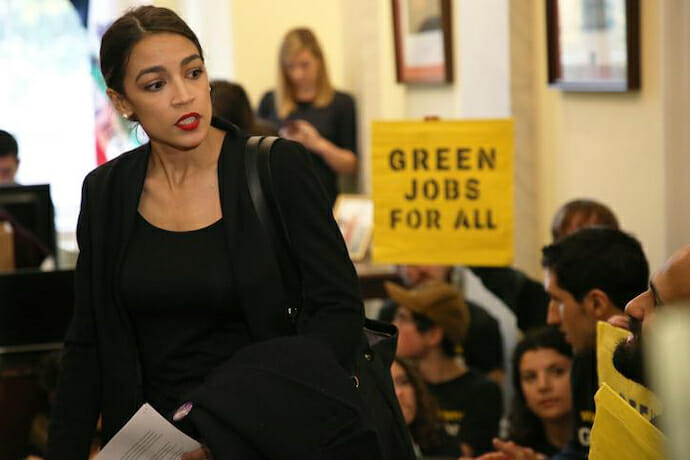
Politics
Does the ‘Green New Deal’ Deserve Serious Consideration?
The new 116th Congress barely started its work as one of its newest members, Ms. Alexandria Ocasio-Cortez, submitted the resolution for a Green New Deal (GND). The choice of the name for the resolution was certainly not accidental. It has important historical references and allusions. By connecting the new initiative with the greatest success of the Democratic Party in the past, the Democrats clearly emphasize the significance they attribute to this proposal. The support that most Democratic hopefuls have expressed for GND indicates that this issue will play a very important role in the next presidential election, particularly in view of the fact that President Trump barely mentioned climate change in his state of the union address.
GND is an ambitious project. It plans to eliminate the US carbon footprint by 2030. America will become one hundred percent (from the current ten percent) reliant on renewable energy (wind and solar), upgrade infrastructure to achieve maximum possible energy efficiency and reduce gas emissions from industry and agriculture. But that’s not all. As the resolution shows, the Democrats want to use climate change as an issue that will mobilize America’s resources to address a variety of problems that it faces today: from poverty and the erosion of the middle class to economic stagnation, racial inequities and oppression, and even to ending wildfires. One gets a sense that GND is the solution to all our problems.
Even before the submission of the plan, critics voiced concerns that went beyond the usual partisan sniping. Perhaps the most important concern is about the resources required to implement this plan. Many ask where the planners will get the money required for covering the enormous cost of this plan. So far there has been no clear answer to this question. The Democrats have only indicated their intention to tax the wealthy 1 percent of the population at the rate of 70 percent and use this money to pursue GND. However, critics have expressed doubts that money provided through this tax will be sufficient. Many also have reservations about the overall impact of GND on the economy. What will be the overall impact of the plan on America’s traditional industries that use fossil fuel? How will the elimination or curtailment of these industries affect the wellbeing of common Americans?
The released version of GND appears to be reductive. The plan uses one single issue—the climate change—as a way of mobilizing economic resources and generating enthusiasm that will stimulate the economy and will help solve other problems we currently face. Such a reductive approach is reminiscent of a trickle-down mentality that singles out one issue for addressing a host of other problems. It underestimates the entangled complexity of economic systems. GND displays more than a tinge of technological determinism with its unbounded belief in scientific and technological progress as a panacea for all our ills.
GND also indicates a lack of awareness of other approaches in dealing with environmental degradation. Most theoretical approaches toward environmental problems have roots in one of the most fundamental laws of nature: the Second Law of Thermodynamics. According to this law, the production of entropy in closed dynamic systems will always be more than zero. A finite environmental system, such as the planet Earth, has limited capacity to sustain the demand in resources and sinks. In other words, there is a limit to how much production and consumption we can have, and this limit determines the maximal size of the population that Earth can support. Many environmentalists point to population growth as one of the major factors that cause environmental degradation. People need housing, food, and other means of sustenance; many of them want a better life, which often means more consumption that can add to the already huge amounts of human waste choking natural sinks.
Several approaches embrace the idea of setting limits to production, consumption, and population growth. Steady state economics and de-growth are probably the two best known among them. The former believe that we should maintain our production at a constant level and make sure that we never exceed it. The latter believe that even our current levels of production and consumption are unsustainable and must be decreased. Obviously, in both cases, the size of the population should either remain constant or even go down. One does not have to agree with these approaches but they raise important issues that deserve attention, even if one disagrees with their proposed solutions.
One can sense in GND an infectious optimistic belief in our ability to solve the problems we face. This belief is not baseless. In the late 18th century Thomas Malthus, a famous British economist and statistician argued that the destruction of the significant part of human population through wars and disease was inevitable due to the discrepancies between the rate of the population and production growth. However, the Industrial Revolution disproved these predictions. A century later Europe was able to sustain a much larger population and achieve greater prosperity and a much higher standard of living. Indeed, economic progress, scientific advances, and technological innovations made possible this break out of the Malthusian loop.
Given this historical precedent, one can understand the implicit optimism of GND. However, what is missing in this document is a realistic assessment of the basis for such optimism. The success of the Industrial Revolution was not unqualified. In addition to the enormous benefits it brought to humanity, it also created new forms of destruction of both human lives and nature. The New Deal ushered in more than just progress and prosperity; it also inflicted enormous damage to our environment. We still live with the consequences of this damage. Also, creativity–scientific, technological, or any other—is highly unpredictable and offers no guarantees. Launching an ambitious program that requires huge commitments in resources based on such an unpredictable factor as human creativity does not strike one as entirely rational. The least this plan could do is to explain how creativity can be enhanced, stimulated, and controlled. It does not even raise this issue.

A project of the magnitude of GND requires more than just counting on faith in inevitable growth. It must offer a clear and rational and detailed plan of what and how will generate this growth. That is what one should expect to find in such a plan, not a reductionist trickle-down mentality.
Ending environmental degradation is certainly a laudable cause, but using it as a mobilization call for addressing the serious problem of growth does not appear to be a good strategy. Such call may produce a lot of enthusiasm, but enthusiasm dissipates very quickly when confronted by unanticipated and unforeseen problems. The optimism of GND should appeal to rational analysis, not just enthusiasm and hope; the resolution submitted by the Democrats does not offer such analysis. Moreover, other than good intentions and wishes, it does not show any awareness of what the project of this magnitude and complexity might involve,
In order to solve a problem, one must clearly understand its cause. Indeed, the problem of economic growth and the state of our environment are closely interrelated. But GND does not correctly determine what constitutes the primary cause in this relationship. It puts the cart before the horse. It is not the state of the environment that causes our economic problems. On the contrary, our economic problems are the source of environmental degradation; and the most important economic problem that we face is the problem of growth.
The ethos of the industrial revolution that swept the world during the 19th century and continued through much of the 20th century did not encourage efforts to protect the environment. We believed that it was our destiny to dominate nature and dictate to it our will. This belief inspired many industrial mega projects of that era that profoundly affected our environment. The attitude that existed at the time led to the abuse of nature.
The situation is very different today. The attitude that existed back in the 20th century has profoundly changed. Today many politicians, business leaders, and activists recognize the importance of the environment for the quality of our life and even our survival. There is plenty of will to protect the environment from abuse and pollution. Yet environmental problems remain. The reason is not a lack of will but mostly the lack of resources.
Protecting the environment is costly. It requires resources. The logic of production dictates that managers should think first and foremost about production and use available resources primarily for the purposes of production. They view expenses unrelated directly to production as externalities. When production works well, taking care of externalities presents no problem; when production staggers, as has been the case over the last several decades, externalities are the first to go.
An efficient and growing economy that creates a lot of wealth and resources is the key to addressing and solving our environmental problems, not the other way around. Creating such an economy requires efficient use of available resources. Our economy, unfortunately, does not meet this requirement. Its most important resource is the human capacity to create. Human creativity is capable of generating rates of growth that increase exponentially. The effects of the emergence of new industries, new resources, applications of scientific discoveries on our economic development can be dramatic. Think for a moment about the effect of the creation of the computer and communication industry. By using efficiently human capacity to create, we can increase the rates of economic growth many times over and produce much more value and wealth, thus generating sufficient resources to address many other problems, including the environment.
However, the sad fact is that we do not use this resource efficiently. In fact, we barely use it at all. Most jobs require nothing more than the performance of routine operations that in today’s world can be eliminated through automation. According to a recent Brookings Institution report on automation about a quarter of American jobs are likely to be seriously disrupted in the near future and over 60 percent will be disrupted partially. The technology available today can automate 42 percent of tasks in finance and insurance occupations and 59 percent of tasks in manufacturing. The report stresses that automation is likely to continue “hollowing out” the middle class, as most jobs and wage gains will concentrate at the high and low end of the labor market.
There is one area, however, where humans best machines; machines cannot match our capacity to create. As the Brookings report indicates automation does not threaten occupations that require creativity. Human creativity is a source of infinite new possibilities. It can lead to unprecedented increases in the rate of production. We can create new occupations and new lines of employment that do not even exist today. Using human capacity to create more widely and more efficiently than we do makes a lot of sense.
Unfortunately, our current economic practice does not stimulate creativity. Only a few major corporations–such as Google, Apple, or Amazon—experiment with practices that encourage ordinary employees to make creative inputs. The theoretical foundation for such practices is still very thin and these experiments remain more an exception than a rule.
Out education is also not geared for helping young people to develop their creative capacity. Teaching, for the most part, consists of the transmission of knowledge, not knowledge creation. There is no methodology for developing skills and habits involved in an act of creation. Moreover, we do not have a clear understanding or even a definition of what creativity is, what it involves, and how it can be controlled.
The reason why our economic practice—or, in fact, also other forms of our social practice–is not conducive to more efficient use of human creativity is the fact that we attribute little importance to the process of creation; we do not even view this important process as central to our life. Our theory and practice reflect the peripheral status of the process of creation in our knowledge. We pay little attention to it and understand it even less.
The problems we face today require creative solutions—that is, they need new approaches that still do not exist and must be created. The old and tired ones no longer work. Our current problems reveal the need to make the process of creation central to our life and practice. We need a new practice that will be organized around the process of creation.
Our current practice does not stimulate creativity. Indeed, acts of creation occur but they occur contrary to our practice, not because of it. The process of creation requires both hierarchical and non-hierarchical interactions. While non-hierarchical interactions create new and more powerful levels of an organization, hierarchical interactions conserve and optimize them. The two types of interactions should be in balance and complement each other. The domination of one or the other disrupts the process and affects its efficiency.
The fact that we know so little about the process of creation and the way it works is the main reason why we cannot balance hierarchical and non-hierarchical interactions. Without this balance, the process of creation cannot function effectively. The domination of non-hierarchical interactions generates instability, and the prevalence of hierarchical interactions and hierarchies stultifies creative impulses.
The process of creation should be central to our new practice; it should serve as the main organizing principle of this practice. Understanding the process of creation will help us gain control over it and use it more efficiently. The encouragement, enhancement, and efficient use of human creativity will lead to increased growth. This growth and wealth that it will create will provide the necessary resources for solving our problems, including the problem of environmental degradation. We cannot solve our environmental problems without solving the problem of economic growth.
We can tax the wealthy all we can, but that is unlikely to generate nearly enough funds to finance the ambitious GND project. We cannot be left wondering where the money for this project is coming from. We will be irresponsible to make the implementation of this project dependent on taxes raised from 1 percent of the wealthiest Americans. Only an efficient and growing economy can sustain a project of the magnitude and complexity of GND.
If the creators of GND want their plan to be taken seriously, they must show that they understand the full magnitude of what they propose. Unfortunately, in its current redaction, GND does not reveal such understanding. It does not even raise the most important problem—the problem of growth–that needs to be addressed before all else, to say nothing about proposing its solution. That is what readers expect to find in this plan; and yet, that is what, sadly, it does not offer.

